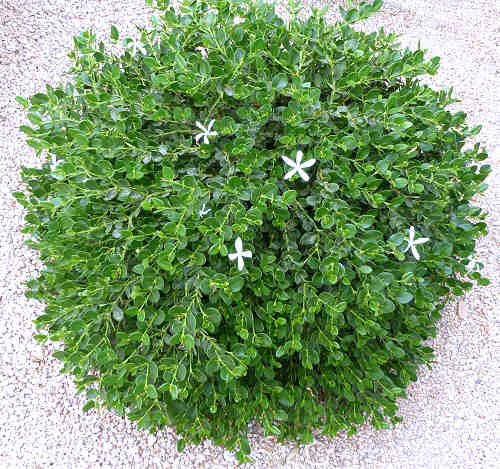Growing Natal Plum:
Carissa macrocarpa
Back to Fruit, Berries and Nuts
Botanical Overview
Natal Plum is a member of the Dogbane family (Apocynaceae), which includes oleander and periwinkle. It is not related to true Plums, which are members of the Rose family.
Description
Form:
Shrub or small tree.
Lifespan:
Perennial.
Leaf retention:
Evergreen.
Growth rate:
Moderate.
Mature Size:
Typically 1-3' (0.3-1m) high and 3-4' (1-1.2m) wide for nursery cultivars.
Dwarf varieties produce smaller fruit.
In its native region, some varieties grow 18-20' (5.5-6m) high.
Flowers:
White, five narrow, thick waxy petals, 2" (5cm) diameter, with a fragrance similar to
jasmine and orange blossoms.
Bloom:
Spring and summer. In some regions, plants will bloom and display fruit most of the year.
Self-fruitful:
Yes. It may need hand pollination.
Years before fruiting:
2.
Fruit:
Red, plum-shaped, 1-3" (2.5-7.5cm) diameter, with 6-16 small edible seeds.
The entire fruit is edible when ripe, tasting like sweet cranberries, strawberries or
raspberries, depending on the degree of ripeness.
There is a latex overtone to the flavor which lessens with ripeness and varies by cultivar.
Months for fruit to ripen:
3. The fruit is ripe when it is pink or red, not green, and is slightly soft to the touch.
These fruits ripen individually and not all at once. They persist on the plant after
ripening.
Storage after harvest:
One day at room temperature, no more than one week refrigerated. The fruit do not ripen
further once picked.
Leaves:
Glossy dark green, thick, oval, smooth margins, sometimes overlapping.
Stems:
Thornless or Y-shaped double spines, milky latex sap if broken or cut.
Roots:
Fibrous, extensive, non-invasive.
Cultivars of Note:
'Fancy' larger fruits with fewer seeds
'Gifford' good crop bearing shrub.
Wildlife:
The flowers attract pollinating insects. The fruit attracts birds and mammals in its native
region.
Toxic / Danger:
Spines are present on most cultivars. The ripe fruit are safe to eat.
Other parts of the plant contain latex, which is mildly toxic, and may result in diarrhea
and vomiting if consumed.
Origin:
The Natal region of South Africa.
Cultivation and Uses
USDA hardiness zones:
9b-11. Young plants need protection below 30°F (-1°C). Established plants survive
25°F (-3.9°C).
If its roots are well mulched, and this plant dies to the ground in a freeze, it will come
back from its roots mid spring.
Chill hours:
None.
Heat tolerant:
Yes.
Drought tolerant:
Moderate.
Sun:
Full sun to part shade. Most cultivars sold in nurseries today do best in part shade.
Planting:
Locate this plant in all day part shade in well draining soil unless directions on the pot
indicate full sun. It can be grown in a container.
Soil:
Well draining, tolerant otherwise. This plant does better in pH 6.1-7.5 (slightly acidic
to neutral) soil, and is tolerant of salinity.
Fertilize:
In soil with a low organic content, apply organic fertilizer mid to late winter before new
growth begins.
Water after becoming established:
Deep water weekly to monthly depending on the size
of the fruit crop and temperature. Deep water monthly in winter. The soil must dry out between
waterings. This plant is subject to root rot in wet soil.
Mulch:
Apply organic mulch to shade the root area from summer heat and winter freezes. Keep the
mulch 8" (21cm) away from the trunk.
First Year Care:
Water every day or two to establish an extensive root system. Do not overwater.
Prune:
It is often pruned into a narrow hedge to make its fruit more accessible, or to serve
as a barrier. After the last frost, remove any dead or damaged branches. Flowers appear
on new growth.
Litter:
Low.
Propagation:
Cuttings, layering, and seed. Seeds are variable and seldom breed true.
Cuttings of young branches must first be cut most of the way through, then allowed to droop
on the plant for two months while they form a callus, then removed and planted in sand where
they will root in about one month. Layering is recommended.
Uses:
Ornamental, edible fruit, barrier hedge. The fruit can be used raw in salads or cooked into
jams and pies. Cooking removes latex from the fruit, which adheres to the sides of pans
and is best removed by rubbing with a paper towel, dry or dipped in a bit of cooking oil.
Prostrate varieties are useful as erosion control on mild slopes.
Prostrate varieties are useful as erosion control on mild slopes.
Comments
A former scientific name is Carissa grandiflora.
The most common cultivars sold in nurseries are low shrubs and groundcover
plants, both with small thorns.
Another closely related shrub is Carissa carandas: Carandas Plum.
Do you have additional information or a different experience for these plants that you would like to share? Email info@GardenOracle.com. All contributions are welcome and appreciated.
Do you have additional information or a different experience for these plants that you would like to share? Email info@GardenOracle.com. All contributions are welcome and appreciated.



Latest update: February, 2024
© 2008-2025 by GardenOracle.com

